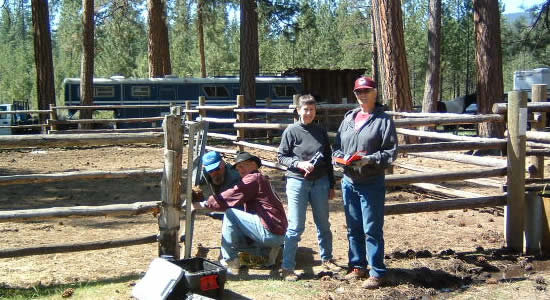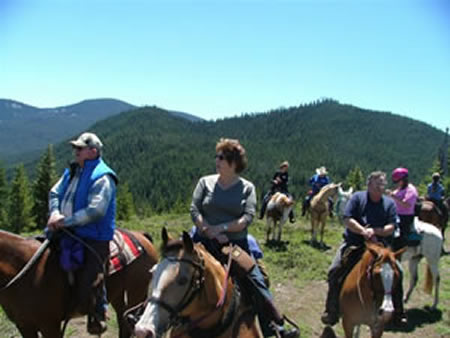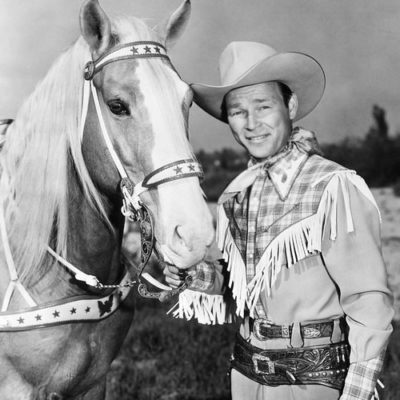LNT #2: Camp and Travel on Durable Surfaces – You create the least impact if you camp in an existing campsite and don’t make the area any larger. If you’re riding on trails, stay on the trail and don’t make it wider or cut switchbacks. Water runs down your tracks and causes erosion. If you camp and travel in remote areas or off-trail, spread your use out. Don’t ride in a line when going cross-country. That creates a trail. Spread out. It takes a lot more work to camp with horses in a remote area and not create impact.
These Leave No Trace (LNT) articles were originally published in the OET Riders Roundup in the early to mid 2000’s. They were written by Bonnie Stockman, a long standing member and supporter of the OET Mission and way. Among her many talents, Bonnie was a Equestrian Leave No Trace (LNT) educator and wrote many articles for the OET Riders Roundup. Today as she watches over us, we honor Bonnie’s work, by reprinting the articles for everyone, so while we ride let’s do our part by leaving no trace and become a better steward of our public lands.
While for many of us, camping in November is the probably one of the last things we think of doing, a lot of us enjoy a fall or winter trail ride. The fall colors are at their best and when the fall colors are gone we often find that we have a better view with the leaves off of the trees.
One of the challenges of fall and winter riding is finding good durable footing that will not be adversely impacted by horses using it when it’s wet. Trails that are good in summer are not always good for winter riding – they can get dangerously slick, for starters. Trails that don’t have a rock or gravel base or that are not well drained can really break down into mud under heavy use, whether by horses, mountain bikes or hikers. While those of us on horses probably get through the mud the easiest, other users may come away from their mud experience with a less than positive attitude towards whoever they think might be to blame for the mud.

In other words, I believe it is especially important for equestrians to camp and travel on durable surfaces, if we want to preserve our right to use trails. The number of backcountry users continues to grow – making every impact by any user seem more important and more visible. As has been said, “they remember you for what you leave behind” and deep, water-filled hoof marks are right up there in some user’s minds with piles of horse poop as incriminating evidence of a lack of sensitivity to proper backcountry ethics on the part of horse users.
Need a recent example of equestrians nearly losing a trail because of mud issues?
One example would be Elijah Bristow State Park. As I understand it (I haven’t ridden there), parts of the trail are near the river and do get muddy. Apparently the park administrator decided to close the trails to equestrian use because of the mud and potential impact of mud and silt on the river. Fortunately many local horse people as well as OET got involved and in the ensuring community meetings, the park administrator backed off, in part because he hadn’t followed the usual protocol of getting public involvement before a decision of this nature. One outcome of this is that OET has contributed money and labor to re-engineering the trails so they can better stand the impact of heavy equestrian use during the wet months.
One thing we want to avoid is signs at the trail head that say “Closed to Equestrian Use”. One way we avoid being regulated out of the woods is not giving land administrators a reason in the first place to shut down equestrian use. This means that during wet weather we think about what impact our horses have on the ground we travel on.
In other words, LNT Principle #2 – Camp and Travel on Durable Surfaces.
What do we mean by LNT Principle #2?
It means that we choose the trails we travel according to how well their surface will stand up to the impact of our horses’ hooves. This might mean that we choose to not go certain places until the drier part of the year. During the fall, winter and spring, we might choose to ride the old logging roads that have been turned into trails, rather than the more fragile trails. We might choose to go riding on the beach rather than up in the woods. We might avoid steeper trails that could be eroded and turned into a trough by too many horse feet digging into wet dirt seeking traction.
Some other tips to lessen your impact:
- When you do come to a muddy patch in a trail, try to go through the middle rather than around the edges – that increases the size of the muddy area and can further widen and erode the trail.
- Avoid heel and toe caulks on shoes, unless traveling over steep or icy terrain. Flat, plate shoes have less potential for trail erosion.
- Spread out rather than riding single file when going cross country. That way, we make many once-traveled paths that will more quickly recover than one many-traveled path that quickly looks like a permanent trail. If possible, we select routes such as dry meadows or hard-packed ridges or areas that are more rocky.
- When crossing a creek – look for the route that is not only safest, but after safety, causes the least damage to the banks and stream bottom.
- When watering our horses, look for a rocky or more solid place to lead them to water. If there is none, carry buckets to them rather than leaving a riparian area filled with hoof marks that look like the cavalry had watered there. We pay attention to our horses, too – will they walk down to water quietly and drink or do they dance around worsening the impact?
Some general camping guidelines – any time of the year:
- Look for a place to camp that is already hardened by use, if we are traveling in a frequently used area. If we are in an area with no established camp, we choose a campsite back in the trees and out of the fragile meadow. Or, perhaps a rocky area – in any case an area where our impact is not so painfully visible to the next traveler.
- When grazing horses in a meadow, we don’t leave them in one place for extended periods of time, until the grass is grazed down to a nubbin. And, when we picket or high-line them for the night, we make sure they are on the most durable surface available.
- It means that when we go for water, we carry a collapsible bucket and make one trip for camp water rather than many, one bottle at a time. I remember a lovely mountain stream up on Mt. Hood – its fragile beauty lessened by the all too obvious path along its banks of too many people’s foot steps.
Keep in mind that Leave No Trace (LNT) is not about rules – its about consciousness and principles. The best way you can practice Principle #2 is to camp and travel with an eye to leaving as little evidence as you can of your passing through.
Backcountry LNT Tip of the Month: Minimize Trampling!
May we always have Mountains and Rivers Without End.
Bonnie & Velvet









Leave a Reply